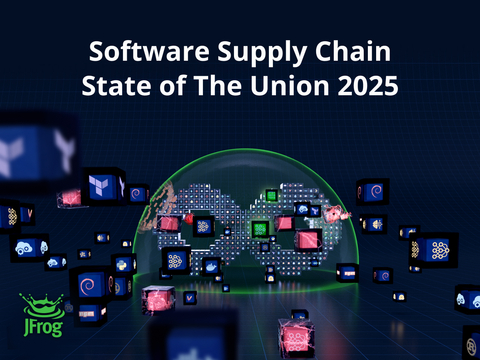Trimble Launches Forestry One to Connect and Streamline Forestry Operations
- Comprehensive research spanning 1,400+ professionals across 6 countries and 7,000+ customers provides valuable industry insights
- 94% of companies are implementing certified lists for ML artifact governance
- JFrog's security research team is actively identifying and analyzing security threats and CVE scoring issues
- 64% YoY increase in exposed secrets/tokens in public registries (25,229 total)
- 6.5x increase in malicious ML models
- Only 43% of organizations perform both code and binary security scans, down from 56% last year
- 37% of companies rely on manual efforts for ML model governance
- 27% increase in new CVEs, outpacing software package growth
Insights
JFrog's report reveals critical security threats affecting software supply chains including misscored vulnerabilities and poor AI/ML governance.
JFrog's comprehensive Software Supply Chain State of the Union 2025 report identifies a concerning "quad-fecta" of security vulnerabilities threatening software integrity: CVEs, malicious packages, exposed secrets, and human errors/misconfigurations. Their research detected
The report highlights a significant disconnect in vulnerability scoring systems. JFrog's security team found only
Particularly alarming is the emerging AI security landscape. With over 1 million new ML models added to Hugging Face in 2024 came a 6.5x increase in malicious models, signaling ML artifacts as an increasingly preferred attack vector. While
The research also identified deteriorating security scan practices, with only
These findings reveal a software security landscape growing more complex faster than organizations can adapt. The
The Software Supply Chain State of the Union 2025 Report Reveals “Quad-fecta” of Security Exploits, Mis-scored CVEs, Poor ML Model Governance, & more are Jeopardizing Trust in Newly Created Software

The Software Supply Chain State of the Union 2025 Report Reveals “Quad-fecta” of Security Exploits, Mis-scored CVEs, Poor ML Model Governance, & more are Jeopardizing Trust in Newly Created Software
"Many organizations are enthusiastically embracing public ML models to drive rapid innovation, demonstrating a strong commitment to leveraging AI for growth. However, over a third still rely on manual efforts to manage access to secure, approved models, which can lead to potential oversights," said Yoav Landman, CTO and Co-Founder, JFrog. "AI adoption will only grow more rapidly. Thus, in order for organizations to thrive in today’s AI era they should automate their toolchains and governance processes with AI-ready solutions, ensuring they remain both secure and agile while maximizing their innovative potential."
Managing and securing the software supply chain end-to-end is an imperative for delivering trusted software releases. By combining insights from over 1,400 development, security and operations professionals across the
Key Report Findings Include:
-
A “Quad-fecta” of Security Vulnerabilities are Threatening the Software Supply Chain: The top security factors impacting the integrity and safety of the software supply chain include: CVEs, malicious packages, secrets’ exposures, and misconfigurations/human errors. As an example, the JFrog Security Research Team detected 25,229 exposed secrets/tokens in public registries (up
64% YoY). The increasing complexity of software security threats are making it harder to maintain consistent software supply chain security. - AI/ML Model Proliferation and Attacks are Growing: In 2024, more than 1 million new ML models were added to Hugging Face, with an accompanying 6.5x increase in malicious models, indicating AI and ML models are increasingly becoming a preferred attack vector for bad actors.
-
Manual Governance of ML Models is Increasing Risk: Most companies (
94% ) are using certified lists to govern ML artifact usage, however over one-third (37% ) of those rely on manual efforts to curate and maintain their lists of approved ML models. This overreliance on manual validation creates uncertainty around the accuracy and consistency of ML model security. -
Limited Security Scanning Leaving Blind Spots: Alarmingly, only
43% of IT professionals say their organization applies security scans at both the code and binary levels, leaving many organizations vulnerable to security threats only detectable at the binary level. This is down from56% last year - a sign that teams still have huge blind spots when it comes to identifying and preventing software risk as early as possible. -
Critical Vulnerabilities Continue to Rise and be Mis-scored: In 2024, security researchers disclosed over 33K new CVEs, a
27% increase from 2023, surpassing the24.5% growth rate of new software packages. This trend raises concerns as the growing number of CVEs increases complexity and pressure on developers and security teams, potentially hindering innovation. Meanwhile, JFrog Security found that only12% of high-profile CVEs rated "critical" (CVSS 9.0-10.0) by government organizations justify the critical severity level they were assigned because they are likely to be exploited by attackers.1 This pattern is troubling due to a centralized and unchanged scoring methodology over time, which heightens the risk of false positives in assessments and contributes to developers experiencing "vulnerability fatigue."
“We uncovered a clear pattern by CVE scoring organizations to inflate scores and cause an unnecessary level of panic in the industry, sending developers scrambling on remediation efforts that often results in wasted cognitive and professional time,” said Shachar Menashe, Vice President of Security Research. “When DevSecOps teams are forced to remediate vulnerabilities that aren’t ultimately harmful, their everyday workflows are disrupted, which can lead to developer burnout and costly mistakes.”
The JFrog Software Supply Chain State of the Union 2025 report also outlines concerns around lack of code provenance visibility across the software supply chain, developers downloading open source software packages directly from public registries without filtering for vulnerabilities, the detriments of “security tool sprawl”, and more. To explore the full findings of this year’s report visit https://jfrog.com/software-supply-chain-state-of-union/ or read this blog.
You can also register to join JFrog security and developer experts on Thursday, April 24, 2025 at 9 AM PT for a webinar, “JFrog’s Software Supply Chain Report 2025: Trends, Threats & Actions,” detailing the challenges and complexities of managing and securing the software supply chain.
Like this Story? Share this on X (a.k.a. Twitter): @JFrog shares research findings in their Software Supply Chain State of the Union 2025 report. Discover the emerging #DevSecOps trends, risks & best practices to securing enterprise #SoftwareSupplyChain. Learn more: https://jfrog.co/43vkg3Y #SoftwareSupplyChain #DevOps #DevSecOps #cybersecurity #containers #CVE
About JFrog
JFrog Ltd. (Nasdaq: FROG) is on a mission to power the world with liquid software. We are replacing endless software updates with a single system of record that seamlessly delivers secure applications from developer to device. The JFrog Software Supply Chain Platform helps organizations build, manage, and distribute software quickly and securely, making applications available, traceable, and tamper-proof. Its integrated security features also help identify, protect, and remediate against threats and vulnerabilities. The Platform also brings ML models in line with all other software development processes, providing a single source of truth for all software components across Engineering, MLOps, DevOps, and DevSecOps teams so they can build and release AI applications faster, with minimal risk and less cost. JFrog’s hybrid, universal, multi-cloud platform is available as both self-hosted and SaaS services across major cloud service providers. Millions of users and 7K+ customers worldwide, including a majority of the Fortune 100, depend on JFrog solutions to securely embrace digital transformation. Once you leap forward, you won’t go back! Learn more at jfrog.com and follow us on X: @jfrog.
____________________ |
1 The JFrog Severity Rating methodology considers the likelihood of vulnerability exploitability, unlike CVSS ratings, which focus only on exploitation severity, often overestimating risks.
View source version on businesswire.com: https://www.businesswire.com/news/home/20250401200753/en/
Media Contact:
Siobhan Lyons, Sr. Manager, Global Communications, siobhanL@jfrog.com
Investor Contact:
Jeff Schreiner, VP of Investor Relations, jeffS@jfrog.com
Source: JFrog Ltd.







